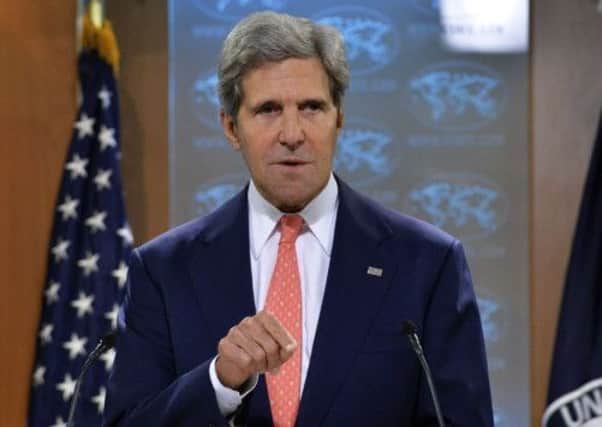US: Syria chemical attack is ‘moral obscenity’


Ratcheting up criticism of Syria’s alleged chemical weapons use, Mr Kerry called last week’s attack a “moral obscenity” that should shock the conscience of the world.
He said the US has additional information about the attack and will make it public in the days ahead.
Advertisement
Hide AdAdvertisement
Hide AdMr Kerry said shelling the affected area afterwards was not the action of a government trying to cooperate with UN investigators trying to assess what happened.
The alleged chemical weapons attack on August 21 that killed hundreds of people has moved the US closer to military action against Syria than at any point during the bloody civil war.
Assad has denied launching a chemical attack.
Syria Q&A
Britain will consider military intervention in Syria’s bloody civil war in the coming days amid mounting tension over president Bashar Assad’s alleged use of chemical weapons. Here is a Q&A examining the conflict that has engulfed the Middle Eastern country.
How did the uprising begin?
The arrest and torture of a group of around 15 children for painting anti-government slogans on a school wall sparked a wave of protests in the southern city of Deraa in March 2011. These escalated when security forces killed a number of demonstrators. The ensuing unrest spread across the country and led to calls for Assad’s resignation.
What happened next?
The government sent tanks into Deraa to crush the uprising and its crackdown became increasingly vicious. In 2012, fighting reached the capital, Damascus, and the city of Aleppo. Last February, rockets and mortars rained down on Homs where the Baba Amr region - a rebel stronghold - became a focal point for the unrest. Subsequent assaults from both sides have led to an estimated 100,000 deaths.
Who are the rebels?
Various political groups, activists, militants and dissidents are united by their desire to oust Assad. But the striking lack of unity among the predominantly Sunni opposition has left it unable to agree on how this can be achieved. A chronic lack of resources has further disadvantaged the rebels. The Free Syrian Army (FSA), a group of early army defectors, is one of the most prominent rebel groups. It describes itself as an “army for all” and claims to be non-sectarian, unlike other opposition branches such as the Syrian Liberation Front or the Syrian Islamic Front, which espouse Islamist ideology. Extremist elements within the opposition movement are believed to have links with al Qaida.
Who has backed the rebels?
As the death toll climbed, foreign nations began siding with the rebel groups. They received logistical support from Western countries and Gulf Arab states sent money for weapons. Last May the EU restricted the supply of weapons used to quash demonstrations. Britain and France asked the EU to reconsider the arms embargo in March, hoping to bolster the rebels’ campaign. In June the White House announced the US would supply direct military aid to the Sunni Muslim opposition and Britain is now considering similar intervention.
Who has backed the government?
Russia has supplied Assad’s regime with arms. Its president Vladimir Putin raised tensions on a recent visit to London when he warned Britain not to try to arm Syrian rebels who “eat the organs” of their enemies. Iran is said to be “committed to preserving” Assad’s regime and was reportedly set to send 4,000 Iranian Revolutionary Guards to the war-ravaged country in June, in support of government forces.
Have civilians been targeted during the conflict?
Advertisement
Hide AdAdvertisement
Hide AdSecurity forces have been accused of deliberately targeting civilians. More than 100 people - around half of them children - died in a massacre in the village of Houla last May. Reports suggested many victims were shot in their homes following a demonstration against the government.
Are chemical weapons involved?
Syria is thought to have some of the world’s largest stocks of chemical weapons - including mustard gas and the nerve agent sarin. Reports suggest the latter was involved in the deadly attack on a suburb of Damascus on Wednesday. Many of the victims had extreme breathing difficulties in the aftermath of the assault while few showed signs of blood or flesh wounds. Images show men suffering convulsions and foaming at the mouth. Assad firmly denies claims that his regime has used chemical weapons, suggesting that opposition forces could be responsible.
How many people have died in the conflict?
UN estimates suggest more than 100,000 people have been killed so far. Around 30 aid workers are believed to have died during the crisis. Sunday Times journalist Marie Colvin was among a number of reporters killed in Syria. Ms Colvin, 56, died in a rocket attack in Baba Amr, alongside French photographer Remi Ochlik, 28, last February.
How serious is the humanitarian crisis?
Estimates suggest more than two million people have been forced to flee their homes - of which a million are believed to be children. Hundreds of thousands of people have fled to neighbouring countries such as Jordan, Lebanon, Iraq and Turkey. Millions more have been offered humanitarian aid in Syria where violence has made it difficult for many to access food, water, electricity and medical supplies. Human rights groups expect more then three million Syrians will have left the country by the end of the year, if current trends persist.